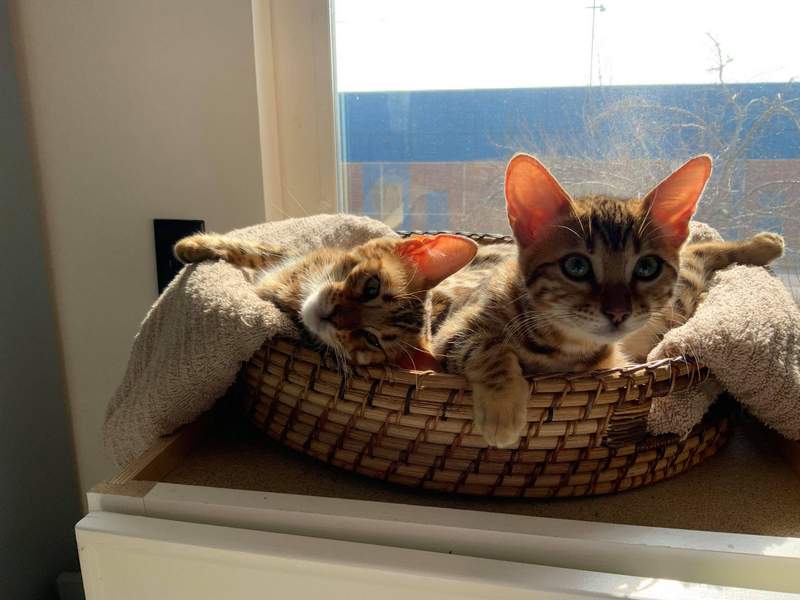One of the most frequent questions we get from people is whether or not Bengal cats are hypoallergenic? The correct answer is yes, they are hypoallergenic, but to fully understand that answer, you must realize that hypoallergenic does NOT mean allergy-free; it means “relatively unlikely to cause an allergic reaction.” Compared to other cat breeds, Bengal cats are less likely to cause an allergic reaction in people, and here is why.
The most common cat allergen
The most common cat allergen is a protein found in cat saliva, skin cells, and urine called Fel d 1. This protein enters the air on cat hair and dander. More people tend to react to this cat protein over the allergens of dogs is its weight. Fel d 1 is so light that it stays airborne longer and is, therefore, more likely to enter the lungs when a person with this allergy walks into a room with cats in it (Konkel). It is also incredibly sticky, so once it lands on a house’s surfaces, it doesn’t go away. Some Oriental breeds produce less Fel d 1; the Bengal is not one of those cats.
However, if a person is lightly sensitive to Fel d 1, not heavily sensitive, they may find that they can be around Bengal cats. Because Bengal cats are single coated, they have less fur than double-coated cats; therefore, they do shed less than some other breeds meaning the protein has fewer hairs to hop onto and enter the air. Also, some Bengals have retained a coat-quality referred to by breeders as pelted. The fur is extremely short and feels like soft rabbit fur. This coat type’s sleekness contributes to its cleanliness and reduces the Bengal’s need to groom itself. With less grooming, less saliva spreads onto the Bengal’s coat, and less hair and dander with Fel d 1 attached to it is released into the air. Having a HEPA air filtration system can be the trick to removing some of the protein particles floating through the air, making Bengal ownership a possibility for some allergy sufferers.
Feeding your cat a raw diet will improve the quality of its skin and fur
Also, feeding your cat a raw diet will improve the quality of its skin and fur. Because the skin of your cat consumes 30% of the protein your cat eats each day when it is fed a diet that is low in protein because it includes ingredients other than meat, organ, and bone, the skin and fur of your cat is not getting enough protein to maintain peak condition (Gates). By feeding your cat a nutritionally balanced raw diet, it is getting all of the nutrients its body needs and none of the ingredients that take away from its proper health. Furthermore, Omega 3 Fatty acids can be added to the raw diet making the skin supple and healthy resulting in a reduction of dander and shedding. Some allergy sufferers have seen their reactions completely vanish once switching their cats onto a raw diet (Hofve).
To sum up, Bengals are hypoallergenic because they groom themselves less often than cats with courser coats and double coats. Feeding your Bengal cat a raw diet rich in Omega 3 can further reduce the amount of hair and dander released into the air making Bengal ownership possible. But, this does not guarantee that every allergy sufferer will not be affected by Bengal cats.
How do you find out if Bengal ownership is going to be a possibility for you?
You need to visit a home with Bengals in it, wait 24 hours, and see if you react. If you know anyone who owns a Bengal cat or two, the best test is to visit a home with one or two Bengals. You may visit the breeder’s home, but since allergens add up, a breeder’s home may not be a realistic test. While individual Bengals produce less of the allergens, when you enter a home with many individuals, you expose yourself to high concentrations of the allergens. You are likely to react to a breeder’s home.
What precautions can you take at home to reduce the chances of having an allergic reaction?
The number one precaution was stated above; feed your cat a raw diet high in Omega 3 to keep its skin and fur in peak condition. Also, getting a filtration system will pull some of the allergens out of the air. Clean your home regularly. Have fewer surfaces that can collect allergens: hard surface floors instead of carpet; leather couch instead of material; wood or plastic window coverings instead of fabric. Put someone else in charge of litter box cleaning since the protein is in the cat’s urine as well. Wipe down your cat with a pet wipe or possibly bathe it, but doing this too often could damage the skin’s natural oils and be counterproductive. And, of course, you may speak to an allergist for further advice.

